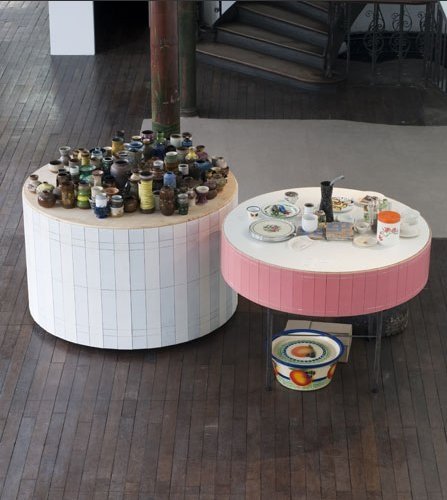Two exhibitions
dal 17/6/2010 al 2/10/2010
Segnalato da
17/6/2010
Two exhibitions
CEAAC Centre Europeen d'Actions Artistiques Contemporaines, Strasbourg
Manfred Pernice / Ivan Seal

Manfred Pernice
Liquidation-tischwelten2
Curated by Bettina Klein
When engaging with a particular territory, one is likely to come across information from various realms of activity. The geographical, historic, economic or cultural data thus collected eventually aggregates into a subjectively biased image of a given place at a given time. The main characteristic and quality of Manfred Pernice's work is its acknowledgement of the simultaneousness of facts and their brittle or soft margins, which it shapes and arranges into a sequence. The entanglement – or 'mash' (liquidation), as he likes to call it – that blends together the artist's life experiences (knowledge, things seen and collected) and the invitations or encounters that are likely to expand the frame of reference and result in an exhibition based on new motifs, forms an intrinsic part of his artistic practice. Related or unexpected things are ordered so as to offer a heterogeneous outlook and overview, which can also be read as a realistic look cast on 'something'.
Combining crystal and ceramic items with miscellanea and found objects laid out on display tables, the setting of liquidation-tischwelten2 is vaguely reminiscent of a department store. Everything must go!
Around 1900 the building in Strasbourg which now hosts the Ceaac (Centre européen d'actions artistiques) housed 'the largest glass and porcelain outlet in Alsace-Lorraine'.1A large number of glass, ceramic and porcelain manufactories had established in Alsace and the greater region2 from the 19th century onwards. Whether a table service from Badonviller, which was smuggled across the border to the Saarland in the 1950s, the latest range of Baccarat crystal ware or a reissue of ceramic bowls from the former Lunéville manufactory, their products bear testimony to the cultural and political developments of the region.
Manfred Pernice's installations often comprise recipients of various provenance. The way in which these are displayed (and thus either highlighted or downplayed) is as significant as their origin: although ceramic products from Strehla on the Elbe3had a stable market share in the GDR, production had to be abandoned in 1997, when it appeared that even manufacturing affordable faience tableware would no longer be profitable. The table with porcelain from Kahla in Thuringia4 evidences a wider interest in the history of the everyday, whose intention to assign a local or supra-regional occurrence to each of the pieces has resulted in an incipient presentation of a ramification or a narrative structure. By so doing, it reflects on the daily use of porcelain and ceramic as recipients which are commonly believed to have an essential connection to 'real' life and are therefore prone to be filled again with history(ies).
----
Ivan Seal
I learn by osmosis
Curated by Bettina Klein
"Painting a block of clay and adding something to it": this is the premise Ivan Seal has imposed on himself as the starting point for a new series of works which he began about a year ago. The paintings from this series represent sculptures, or at least sculptures in the making. Their material presence is manifest: blocks of clay in various sizes and formats sitting atop pedestals, some thrust in a precarious position and barely kept in place by a string. Others are studded with matches, nails or cigarette butts. One of the blocks seems to be partitioned by three strings, but when trying to follow their course, viewers soon realise that they are stuck half-way, fastened at a highly improbable angle. Though crude and sturdy at first glance, the presence of this alleged sculptural matter is led ad absurdum by its surfaces and details. The fair-coloured lumps and pedestals are bathed in a cold neon light, standing out against an indistinctly black background. Despite the plainness of the material, the settings radiate an exaggerated artificiality, to the effect that the blocks of clay appear like malleable primeval matter from which anything — from spherical forms reminiscent of marbles to organic, tube-shaped objects — could emerge. The use of painterly trompe l'oil effects such as drop shadows and modulated volumes further enhances their material presence, but the ambivalence effectively remains to the extent that they consist of nothing more than paint, colour and brush strokes.
For the exhibition at CEAAC, the artist first proceeded to select from among his body of work a number of existing paintings, for which he then painted 'counterparts' that reprise and variegate some of the originals' features. The installation is rounded off by a sound piece with associative words spoken by the artist ('it looks like a tower', 'on the pedestal', 'on the floor', 'a still life', 'a face made of matches', 'here is now there'...), from which a computer generates an endless poem. Echoing the variations of objects in the paintings, language is here used as a material subject to modulation. Seal thus constructs several levels of critical distance vis-à-vis the painterly gesture: defining a conceptual premise; selecting works together with the curator; painting their 'counterparts'; linking them to language; and finally adding a computer that puts the words in a random order and thus triggers constantly new connections in the viewer's mind. Quoting a novel by Franz Werfel1, the title of the exhibition, I learn by osmosis, succinctly sums up this process.
1) Franz Werfel, Stern der Ungeborenen (Star of the Unborn), 1946
Press contact:
Karine Jumel, +33 (0)3-88-25-69-70 karine.jumel@ceaac.org
Image: Manfred Pernice, liquidation-tischwelten2 (détail). Photo Klaus Stöber.
Vernissage June 18th h 6pm
CEAAC, Centre Européen d'Actions Artistiques Contemporaines, Strasbourg
7, rue de l'Abreuvoir F-67000 Strasbourg, France
Hours: wednesday - saturday 2pm to 6pm
Closed from August 1st to 31st 2010.



